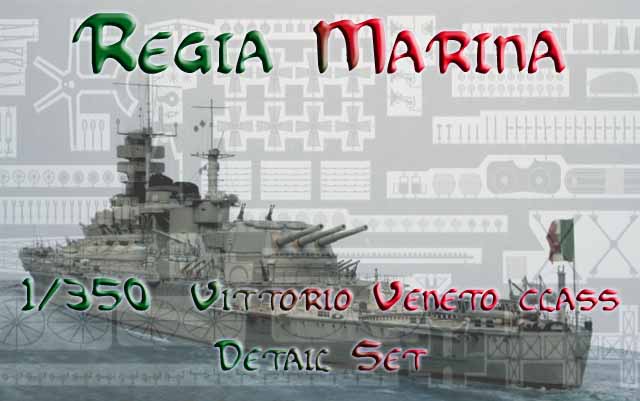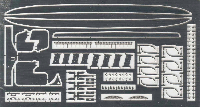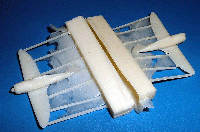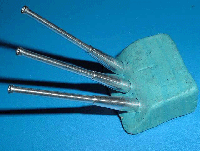
by Sean Hert

|
The Italian Vittorio Veneto class of battleships is one of the more elegant battleship classes to ever hit the water. Optimized for operations in the Mediterranean, the Veneto's had no need for long range bunkerage; that weight savings could be applied to other areas, like protection and speed. In the end, however, none of the Vittorio Veneto 's lived up to expectations, as their operational histories can attest. The Roma has the dubious distinction of being the first battleship sunk by a guided bombs; "Fritz X's", launched by DO-217 bombers of the German Luftwaffe. Regia Marina has a comprehensive set of 5 sheets of stainless steel photoetch available to complete the ill-fated Axis Roma kit, or to compliment the Delphis kit, as any of the ships in this class. This set includes the raised letters to name each of the 4 ships in the class including the not completed Impero as well as Italia , to which Littorio was renamed in 1943. There are some dual part options included; Vittorio Veneto and Littorio differed slightly from Roma, and this is reflected in the options available. This is also the detail set used by Jim Baumann in his build of Roma, seen here. |
|||||||||||||||||
| PHOTOETCH | |||||||||||||||||
FRET A |
|||||||||||||||||
 |
|||||||||||||||||
|
Fret A is etched from thicker steel than the others. This makes sense, as these are parts which either simulate actual structral parts, or need the added strength for stability. The bilge keels and rudders and the breakwater are present. There are two types of boat davit options, depending on what ship you are building. Choose you vessel, read the directions and plan accordingly. |
|||||||||||||||||
|
|||||||||||||||||
FRET B |
|||||||||||||||||
 |
|||||||||||||||||
|
Fret B is first part a two-fret combo of detail parts. According to the instructions, there are two parts on B that should NOT be used ("X"'d out; B47 and B50); instead, there are replacements available on B1. However, there are some differences between the actual frets and the artwork in the instructions; I believe the parts on B1 are still correct. Also included are the Breda AA machine guns, the ship's boat cradles, and the aircraft launching catapult, with launch dolly. My favorite part on this fret is Littorio's unofficial motto plate which reads "Molti Nemici, Moloto Onore" or "Many Enemies, Much Honor." |
|||||||||||||||||
|
|||||||||||||||||
FRET B1 |
|||||||||||||||||
 |
|||||||||||||||||
|
Fret B1 contains structural detatils, etched anchor chain, and the propellor blades, in addition to the replacement parts for Fret B. |
|||||||||||||||||
|
|||||||||||||||||
FRET C |
|||||||||||||||||
 |
|||||||||||||||||
|
Fret C consists of details for the ships's boats, the liferafts and the aircraft. The airplane details include wings with control surfaces, tail and prop for the Ro.43, and tail and prop for the Re 2000. |
|||||||||||||||||
|
|||||||||||||||||
FRET D |
|||||||||||||||||
 |
|||||||||||||||||
|
Fret D is made up of 3 types of railings, ladders and an impressive number of pieces to make the accomodation ladders. The main railing does not include a bottom rail to ease attaching it to the hull, which some modelers may not like. |
|||||||||||||||||
|
|||||||||||||||||
FRET E |
|||||||||||||||||
 |
|||||||||||||||||
|
This fret consists of many various details throughout the ship. Brackets, braces and gratings from stem to stern are on this sprue, including the "starfish" and an upgraded searchlight platform for Roma (E40-43). Part E27 folds into the Gufo (Owl) radar antennas needs for summer 1943 on. Careful planning and research will be required to correctly identify and place all these parts; for instance, the funnel grates for Littorio/Italia/Vittorio Veneto (E9-10) and Roma (E12) are included. |
|||||||||||||||||
|
|||||||||||||||||
| RESIN | |||||||||||||||||
 |
|||||||||||||||||
|
Here are some of the resin pieces included in the set Modelwarships received from Regia Marina; the RE 2000 fighter x2, the Ro.43 biplane x2, and a internal piece for the aircraft catapult. |
|||||||||||||||||
|
|||||||||||||||||
| BARRELS | |||||||||||||||||
 |
|||||||||||||||||
|
A full set of turned aluminum barrels is also part of this set. Included are 9 of the 15"/ 381/50 mm main rifles, and 12 x 6.1"/ 155/55 mm SP secondaries. The barrels do exhibit a taper that looks greater than prototype. |
|||||||||||||||||
|
|||||||||||||||||
| DECAL | |||||||||||||||||
 |
|||||||||||||||||
|
A decal sheet is included with markings for both types of aircraft. |
|||||||||||||||||
| INSTRUCTIONS | |||||||||||||||||
|
The Instructions consist of 7 double-sided photocopied pages. Some of the pages have images of the photoetch frets on them; however, I think they were based on the prototype. The iamges of the frets have items "X"'d out, attempting to reflect the reality of the fret. The actual steps are laid out haphazardly, with copies of drawings or photos of the Barbieri model a lines indicating part placements. The instructions do define seperate steps that are ship specific; however, these directions are a best a guideline; in addition, careful planning and research will be required. |
|||||||||||||||||
|
|||||||||||||||||
| CONCLUSIONS | |||||||||||||||||
 Conclusions: Conclusions:
Thanks to Regia Marina for the review sample. It is nice to see photoetch finally available to complete the Axis and Delphis models. I wish the instructions were clearer and more detailed, but none of these model kits are really intended for beginners. |
|||||||||||||||||
